
James Charles Laker was an English professional cricketer who played for Surrey County Cricket Club from 1946 to 1959 and represented England in 46 Test matches. He was born in Shipley,West Riding of Yorkshire,and died in Wimbledon,London.

Hedley Verity was a professional cricketer who played for Yorkshire and England between 1930 and 1939. A slow left-arm orthodox bowler,he took 1,956 wickets in first-class cricket at an average of 14.90 and 144 wickets in 40 Tests at an average of 24.37. Named as one of the Wisden Cricketers of the Year in 1932,he is regarded as one of the most effective slow left-arm bowlers to have played cricket. Never someone who spun the ball sharply,he achieved success through the accuracy of his bowling. On pitches which made batting difficult,particularly ones affected by rain,he could be almost impossible to bat against.
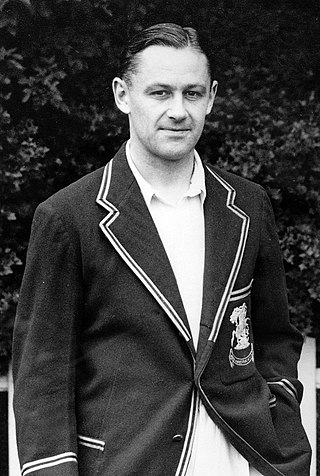
Sir George Oswald Browning"Gubby" Allen CBE was a cricketer who captained England in eleven Test matches. In first-class matches,he played for Middlesex and Cambridge University. A fast bowler and hard-hitting lower-order batsman,Allen later became an influential cricket administrator who held key positions in the Marylebone Cricket Club (MCC),which effectively ruled English cricket at the time;he also served as chairman of the England selectors.
John Brian Statham,was an English professional cricketer from Gorton,in Manchester,who played for Lancashire County Cricket Club from 1950 to 1968 and for England from 1951 to 1965. As an England player,he took part in nine overseas tours from 1950–51 to 1962–63. He specialised as a right arm fast bowler and was noted for the consistent accuracy of his length and direction.
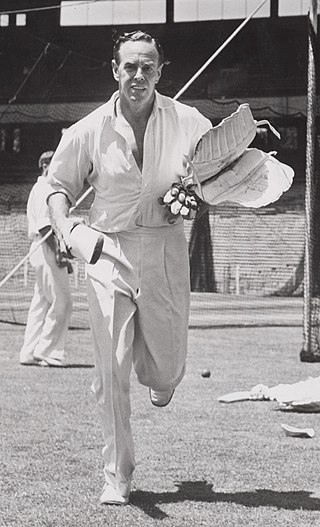
Ian William Geddes Johnson,was an Australian cricketer who played 45 Test matches as a slow off-break bowler between 1946 and 1956. Johnson captured 109 Test wickets at an average of 29.19 runs per wicket and as a capable lower order batsman made 1,000 runs at an average of 18.51 runs per dismissal. He captained the Australian team in 17 Tests,winning seven and losing five,with a further five drawn. Despite this record,he is better known as the captain who lost consecutive Ashes series against England. Urbane,well-spoken and popular with his opponents and the public,he was seen by his teammates as a disciplinarian and his natural optimism was often seen as naive.

Fazal Mahmood PP,HI was a Pakistani international cricketer. He played in 34 Test matches and took 139 wickets at a bowling average of 24.70. The first Pakistani to pass 100 wickets,he reached the landmark in his 22nd match.
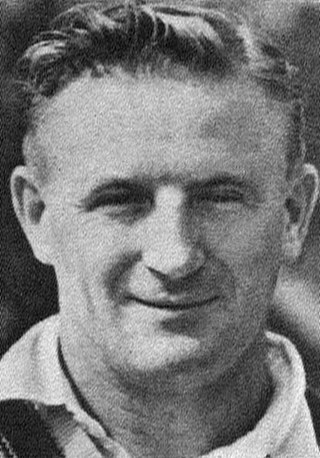
Colin Leslie McCool was an Australian cricketer who played in 14 Test matches between 1946 and 1950. McCool,born in Paddington,New South Wales,was an all-rounder who bowled leg spin and googlies with a round arm action and as a lower order batsman was regarded as effective square of the wicket and against spin bowling. He made his Test début against New Zealand in 1946,taking a wicket with his second delivery. He was part of Donald Bradman's Invincibles team that toured England in 1948 but injury saw him miss selection in any of the Test matches.
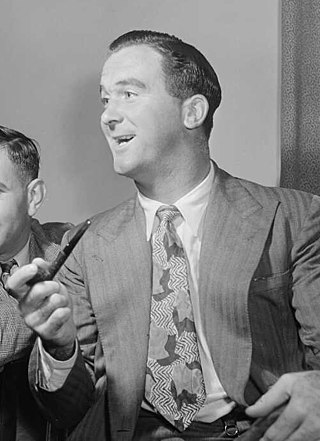
Thomas Godfrey Evans was an English cricketer who played for Kent and England. Described by Wisden as 'arguably the best wicket-keeper the game has ever seen',Evans collected 219 dismissals in 91 Test match appearances between 1946 and 1959 and a total of 1066 in all first-class matches. En route he was the first wicket keeper to reach 200 Test dismissals and the first Englishman to reach both 1000 runs and 100 dismissals and 2000 runs and 200 dismissals in Test cricket. He was a Wisden Cricketer of the Year in 1951.
Lancelot Richard Gibbs is a former West Indies cricketer,one of the most successful spin bowlers in Test cricket history. He took 309 Test wickets,only the second player to pass 300,the first spinner to pass that milestone,and had an exceptional economy rate of under two runs per over.

Donald Dearness Blackie was an Australian Test cricketer who played three Tests as an off-spinner in the summer of 1928–29. At 46 years 253 days of age at the time of his Test debut,Blackie remains the oldest debutant in Australian Test cricket.
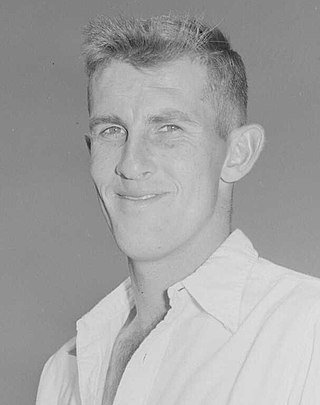
John Chaloner Alabaster is a former cricketer who played 21 Test matches for New Zealand between 1955 and 1972. A leg-spin bowler,he was the only New Zealander to play in each of the country's first four Test victories. In domestic cricket was often partnered at the crease for his provincial side Otago by his younger brother Gren,who bowled off-spin. A schoolteacher,he later served as Rector of Southland Boys' High School in Invercargill.

Douglas Thomas Ring was an Australian cricketer who played for Victoria and for Australia in 13 Test matches between 1948 and 1953. In 129 first-class cricket matches,he took 426 wickets bowling leg spin,and he had a top score of 145 runs,which was the only century of his career.
Fred Barratt played first-class cricket for Nottinghamshire County Cricket Club from 1914 to 1931 and represented England in five Test matches,one in the home series against South Africa in 1929 and four on the inaugural Test series against New Zealand in the 1929–30 season. He was born in Annesley,Nottinghamshire and died at Nottingham General Hospital,Nottingham.

David Bartlett Pithey was a Rhodesian cricketer who played in eight Tests for South Africa from 1963 to 1967. As well as playing for Rhodesia and Western Province,he played first-class cricket for Oxford University and Northamptonshire. Christopher Martin-Jenkins described him as "spasmodically brilliant". His brother,Tony,also played Test cricket for South Africa;they played together in five of the Tests on the 1963–64 tour of Australasia.
David Thomas Dewdney is a West Indian former international cricketer who played in nine Test matches between 1955 and 1958.
Peter May captained the English cricket team in Australia in 1958–59,playing as England in the 1958-59 Ashes series against the Australians and as the MCC in their other matches on the tour. It was widely regarded as one of the strongest teams to depart English shores,comparable with the great teams of Johnny Douglas in 1911-12 and Percy Chapman in 1928-29. It had no obvious weaknesses,and yet it was beaten –and beaten badly. By the First Test the top batsmen had made runs,the Surrey trio of Loader,Laker and Lock had taken wickets,as had Lancashire's Brian Statham. South Australia,Victoria and an Australian XI had all been beaten –the last by the crushing margin of 345 runs –and all seemed rosy for Peter May's touring team. But in the Brisbane Test they lost by 8 wickets and the rest of the series failed to offer any hope of reversing their fortunes. The reasons for their failure were manifold;the captain was too defensive;injuries affected their best players;others were too young and inexperienced such as Arthur Milton,Raman Subba Row,Ted Dexter,Roy Swetman and John Mortimore,or at the end of their career;Godfrey Evans,Trevor Bailey,Jim Laker,Willie Watson and Frank Tyson. Their morale was further bruised when faced with bowlers of dubious legality and unsympathetic umpires. Peter May was criticised for seeing his fiancée Virginia Gilligan,who was travelling with her uncle the Test Match commentator Arthur Gilligan. The press blamed the poor performance on the team's heavy drinking,bad behaviour and lack of pride –a foretaste the treatment losing teams would receive in the 1980s. It was not a happy tour by any means and it would take 12 years to recover The Ashes. As E.W. Swanton noted
It was a tour which saw all sorts of perverse happenings –from an injury list that never stopped,to the dis-satisfaction with umpiring and bowlers' actions that so undermined morale. From various causes England gave below their best...
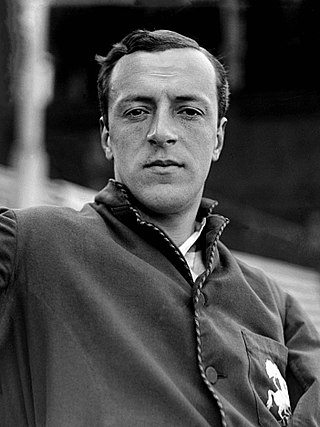
Bernard James Tindal Bosanquet was an English cricketer best known for inventing the googly,a delivery designed to deceive the batsman. When bowled,it appears to be a leg break,but after pitching the ball turns in the opposite direction to that which is expected,behaving as an off break instead. Bosanquet,who played first-class cricket for Middlesex between 1898 and 1919,appeared in seven Test matches for England as an all-rounder. He was chosen as a Wisden Cricketer of the Year in 1905.

Walter Thomas Walmsley was a cricketer who played first-class cricket for three Australian state teams and for Northern Districts in New Zealand between 1945–46 and 1959–60.
Allan Russell Frost is a former cricketer who played first-class cricket for South Australia from 1965 to 1968.
Edwin Frederick Schreiber was a South African cricketer who played first-class cricket for Border from 1954 to 1967.













